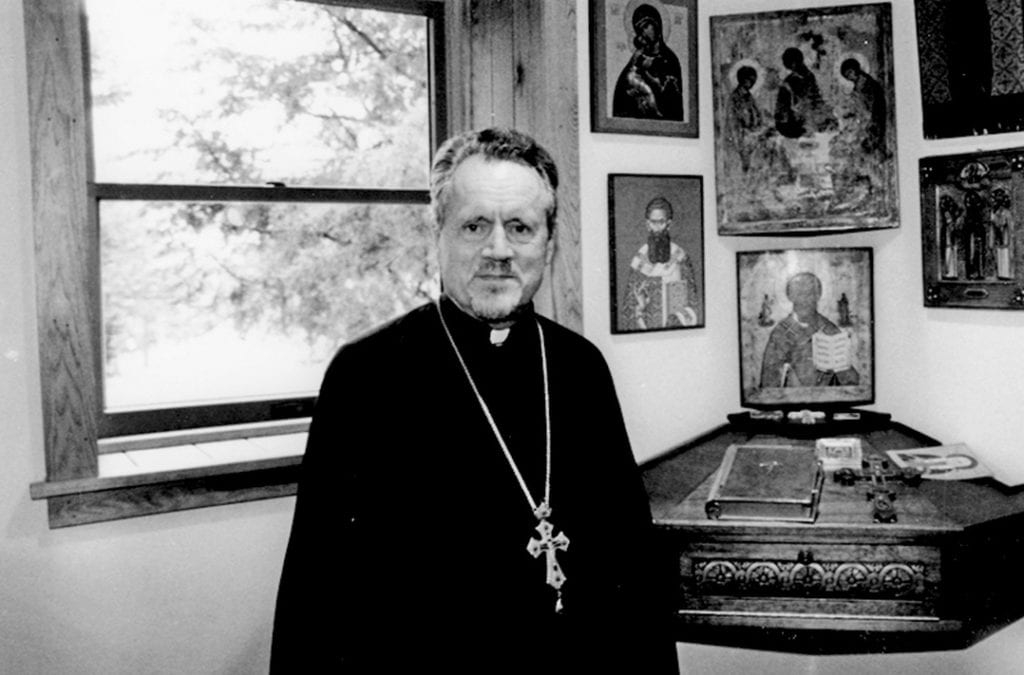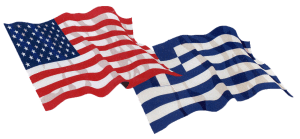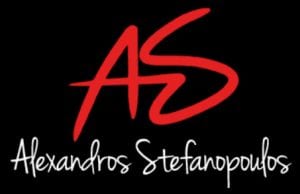by Paul Meyendorff
Fr John arrived in America with his family in October of 1959 to assume a teaching position at St Vladimir’s Orthodox Theological Seminary, at a time when Orthodoxy in America was emerging from its ethnic cocoon.
In 1960, just months after his arrival, The Standing Conference of the Orthodox Christian Bishops in America (SCOBA) was founded. The three largest Orthodox jurisdictions in America were at this time led by three visionary leaders: Archbishop Iakovos of the Greek Orthodox Archdiocese, who became the first chairman of SCOBA; Metropolitan Leonty of the Metropolia: and Metropolitan Anthony Bashir of the Antiochian Orthodox Christian Archdiocese. High on the agenda of SCOBA was the express desire for canonical unity in North America, and all three of these hierarchs repeatedly spoke on this subject. Indeed, Archbishop Iakovos, in his opening remarks at a January 1965 meeting of SCOBA, praised Metropolitans Leonty and Anthony for their vision and emphasized that the Standing Conference must acquire a regular canonical status, as the Provincial Synod of the American Church, according to the Canons and with the blessing of the Mother Churches.[1]
In 1965, Fr John was appointed editor of the new Metropolia newspaper, The Orthodox Church, a position he held until his retirement in 1992. As editor of this monthly publication he wrote numerous editorials calling for Orthodox unity, and later defending the autocephaly of the Orthodox Church in America (OCA) after this was granted in 1970. His very first editorial, published in February 1965, concludes with the following words:
It seems, however, that we are approaching a new period in the history of our Church. Practically everyone understands that the present situation cannot last. The Standing Conference of Orthodox Bishops is watched by millions of laymen with great expectation. Nothing, however, will be done unless all realize exactly why Orthodox Unity is necessary.
The reasons are spiritual, canonical, and practical.
Spiritually, it is obvious that when we confess our belief in “One, Holy, Catholic and Apostolic Church,” this belief is meant to be the guiding principle of our lives: God is one, the Lord Jesus Christ is one, and the Church must be one also. “National” churches can exist only inasmuch as they accept to submit their particular interests to that of the whole Body of Christ.
Canonically, the rules and canons of all churches strictly forbid the existence of parallel ecclesiastical organizations on the same territory.
Practically, the Orthodox witness in this country will be immensely strengthened if the three million Orthodox pray and work together; if others are able really to see in us the One True Church, and not a conglomeration of mutually exclusive factions; if we can all join our forces in the education of our youth.[2]
A year and a half later, at a time when the autocephaly of the Metropolia was still a distant dream, his call for a resolution to the canonical issues grew louder. I cite extensively from an editorial entitled “’Mothers’ and ‘Daughters,’” published in the August-September 1966 of The Orthodox Church:
…the fate of the Church in the Western world is in our hands or rather should be [emphases in original]in our hands. The canonical conditions of normal Church life are clearly spelled out by the tradition of the Church: everywhere, Orthodox Christians must constitute one Church, led by its own bishop and priests. Through its bishop, each Church must be in communion with the Church universal. All the institutions of the Church – patriarchates, metropolitan districts, autocephalies, archdioceses – exist in order to secure this essential order of the Church.
The tragedy of our times – and the origin of the disorder in which we live – is that these institutions are being used for non-ecclesiastical purposes: patriarchates, while considered by some as infallible criteria of canonicity, are being used by the governments of the countries in which they are situated as political tools; archbishops and metropolitans consider themselves as national, and not ecclesiastical leaders. Meanwhile, Orthodox canon law does have provisions against those abuses: it clearly requires that all ecclesiastical questions are to be solved in the area where they arise. African bishops in the fifth century even excommunicated those who appealed “beyond the seas” to solve their problems. They would certainly consider as highly uncanonical that the Antiochian American Archdiocese, for example, should have its fate resolved by a Synod meeting in a foreign country thousands of miles away.
Our conclusion today is that our internal disunity and disorder in America will last until the time when the patriarchates – the “Mother Churches” – as well as their representatives here and all the other ecclesiastical institutions will at last realize their proper function and will prove themselves able to perform it. For the time being, by simply demanding that we submit to them, they continue to divide the Church and, in fact, want only that we serve their interests – which are not the interests of the Church in America. Their proper and obvious ecclesiastical duty is to urge and help American Orthodox to realize their unity while at the same time preserving all the national traditions, languages and customs which need to be kept.[3]
These two examples – and there are many more – clearly indicate Fr John’s public role in the search for Orthodox unity in America and for the eventual granting of autocephaly. Behind the scenes, much was going on as well, and here too he played a central role.
It was at the 1961 World Council of Churches Assembly in New Delhi, India, that the Russian Orthodox Church joined the ecumenical movement, and this allowed contact between the Metropolia and the Russian Orthodox Church to resume after a hiatus of nearly forty years. Here Fr John was able to meet and to speak informally especially with Metropolitan Nikodim of Leningrad, chairman of the External Affairs Department of the Russian Church. This informal meeting led to further encounters in 1963, this time in the United States, and then again in November 1967, at which time Metropolitan Nikodim asked for a “sign” from the Metropolia that it desired to enter into negotiations. Throughout the 1960s, Fr John maintained informal contacts with Metropolitan Nikodim, as well as Metropolitan Anthony Bloom, who encouraged the Metropolia to develop and maintain contact with the Moscow Patriarchate.[4] Then in August 1968, this time at the WCC Assembly in Uppsala, Sweden, Nikodim informed the Metropolia’s delegation that the Patriarchal Synod was ready to enter into negotiations. At each of these encounters, Fr John was present and took a leading role.
Fr Meyendorff reported on this conversation to Metropolitan Ireney, primate of the Metropolia, who indicated his willingness to continue the dialogue. On September 22, 1968, Fr John sent a personal letter to Metropolitan Nikodim informing him that the Metropolia was ready to hold a secret and informal meeting between representatives of the two churches.[5] The letter further proposed that the meeting take place either in Belgrade or Geneva. An affirmative response from Moscow, signed by Metropolitan Nikodim, was sent on December 20, 1968.[6]
The immediate result was a series of “unofficial” meetings in New York, the first on January 21, 1969, at the New Yorker Hotel, the second on February 3, 1969, in Syosset, NY, at the residence of Metropolitan Irinei. The Moscow delegation was at both meetings headed by Metropolitan Nikodim. The Metropolia delegation consisted of a special commission for this purpose appointed by Metropolitan Ireney and headed by Bishop Kiprian of Pennsylvania, and including Fr Joseph Pishtey, Chancellor of the Metropolia, Frs Alexander Schmemann, John Skvir, John Meyendorff, Kirill Fotiev, as well as Professor Sergius Verhovskoy.
At the January 22 meeting,[7] it was agreed that this meeting would be considered unofficial, but that the subsequent meeting in February would be official and would draft a formal agreement for presentation to the Holy Synods of the Moscow Patriarchate and the Metropolia. Metropolitan Nikodim began by pointing out that the situation in America was fundamentally different from that in Western Europe, where there had never been a diocese of the Russian Church, while a Russian diocese existed in America until 1922. He further stated that it would be pointless to speak of the reasons that led to the break between the mother church and the Metropolia; rather, the focus should be on the future. At this point, Fr Meyendorff summarized the points discussed back in 1963: 1) the granting of autocephaly in accordance with canon law, and its recognition by the other local churches; 2) the recognition by Moscow of the new autocephaly as the complete successor of the mission and exarchates of the Russian Church; and 3) the suppression of the Exarchate, with the exception of a representation church. Metropolitan Nikodim expressed his agreement, but stated that the St Nicholas Cathedral in New York must be kept by the (Moscow) Patriarchate. In the ensuing discussions, Fr Schmemann asked Metropolitan Nikodim how the local churches, particularly Constantinople, would receive the granting of autocephaly. Nikodim replied that Constantinople would not be happy, but that this would not be a problem. Did Constantinople ask anyone when it established its new diocese in America in 1922? He then expressed his certainty that other groups would eventually join the autocephaly. Further, the non-recognition of the autocephaly might well lead to an inter-Orthodox meeting: by what right can the Greek churches not recognize the right of the Russian Church to grant [autocephaly]to its former diocese, the first on this [American] continent, whose jurisdiction over America no one considered challenging before 1922? After discussion of the church in Japan and several minor issues, the meeting concluded with an agreement to meet on February 3.
Though still officially an “informal” meeting, this gathering discussed the formal details of the granting of autocephaly and agreed upon a formula to be presented as a formal request to the Holy Synod of the Russian Orthodox Church from the Holy Synod of the Metropolia. The proposal was set on paper and signed by Metropolitan Nikodim and Bishop Kiprian. The agreement listed the following points:
1) the Russian Patriarchate would a terminate its jurisdiction in America;
2) the Patriarchate would grant autocephaly to the Metropolia;
3) all property and rights belonging to the Patriarchate would be transferred to the autocephalous church, with the exception of St Nicholas Cathedral, which would have the status of “podvorie” (representation church);
4) the securing by the Patriarchate of the recognition of the autocephaly by all local Orthodox Churches.
After the agreement reached in Syosset was approved by the Holy Synods of both churches, an official meeting was held in Geneva, Switzerland, on August 24-25, 1969, to prepare the final steps for the formal declaration of autocephaly and the issuing of the Tomos. One of the Russian representatives at this meeting was Hieromonk Kirill (Gundiaev), a close associate of Metropolitan Nikodim and the current Patriarch of Moscow. Among the details resolved at this meeting was the continued presence in America of a small number of parishes under Moscow, as well as an agreement to hold a meeting in Tokyo of representatives of the Moscow Patriarchate, the Metropolia, and the Japanese Orthodox Church to resolve the canonical situation in Japan, and to resolve some final questions about the autocephaly of the Metropolia.[8]
It was following this meeting that the negotiations and final agreement became public, and the External Affairs Department was charged with informing the dioceses about these developments. Bishop Kiprian and Frs Pishtey and Schmemann personally presented reports to the various diocesan assemblies that fall, and the Metropolitan Council (the administrative body of the Metropolia in the intervals between all-church councils) was briefed. Fr Meyendorff, in his role as editor of the church newspaper, The Orthodox Church, wrote a series of editorials that appeared in each issue, all addressing the issue of autocephaly and answering the objections of doubters.[9] I cite from his December 1969 editorial:
The establishment of an autocephalous “Orthodox Church of America” by the Patriarchate which first brought and organized Orthodoxy in America will solve the painful conflict between the Metropolia and its Mother Church. But it also will provide American Orthodoxy as a whole with a new and unquestionable opportunity. The existence in the same country of several parallel Orthodox jurisdictions – the Greek, the Russian, the Syrian, the Romanian, the Albanian, etc. – is a canonical abnormality which hampers the spiritual and social witness of Orthodoxy. In the eyes of an outsider, we appear as a congregation of ethnic tribes. All must find their place in the one Orthodox Church of America.
Obviously, there can be no question of making this unity “under the Russians.” Autocephaly implies the end of ecclesiastical colonialism: Church life in America must have no other goals than the progress of Orthodoxy in this country and the contribution to the progress of the faith everywhere. It cannot serve particular interests. But it can and must preserve and guarantee all national traditions…[10]
The rest of the story is well-known. On April 10, 1970, the Tomos of Autocephaly was signed, and on May 18 of the same a year, a delegation from the Orthodox Church in America, led by its youngest hierarch, Bishop Theodosius of Sitka and Alaska, traveled to Moscow for the official ceremony. It is interesting to note that neither Fr Meyendorff nor Fr Schmemann made the journey for this event, and it was not until years later that Fr John first traveled to Russia.
The autocephaly of the Orthodox Church created what Fr Schmemann called “a meaningful storm.”[11] Although the leading hierarchs in America, particularly Archbishop Iakovos of the Greek Archdiocese and Metropolitan Philip of the Antiochian Archdiocese were kept fully informed during the negotiations that led to autocephaly and had expressed their public support for Orthodox unity in America, a strong negative reaction followed, particularly from the Greek side. Archbishop Iakovos even broke communion with the OCA for a brief time. And in the years immediately following the issuing of the Tomos, a lively debate ensued, in which Fr John took an active part. He did so on several fronts.
First was a series of editorials in The Orthodox Church defending the position of the OCA.[12]Perhaps the strongest language he used was in an editorial published in December 1970 and entitled “Against Myths”: He first rejects the misconception that SCOBA (the “Standing Conference of Bishops in America”) had itself been planning for American autocephaly, a project that was then derailed by the unilateral actions of the Metropolia and the Russian Church. Fr John then reports that an appeal to the Pan-Orthodox Conference in Chambesy, Switzerland; “but THE ECUMENICAL PATRIARCHATE REFUSED TO PLACE THE ISUE ON THE AGENDA” (capitalization in the original text). He reports further that, back in 1967, Metropolitan Ireney of the Metropolia had written a letter to all Orthodox patriarchs of the necessity of unity, and that he later requested an audience with the Ecumenical Patriarch (a request supported by Archbishop Iakovos), but that this request was turned down in a telegram. Through unofficial channels, Constantinople stated that the Metropolia would first have to solve its problems with Moscow. He continues:
During the negotiations with Moscow, the Chairman and the Vice-Chairman of the Standing Conference [Archbishop Iakovos and Metropolitan Philip] were receiving detailed briefings; and nothing, at any time was done secretly.
The myth of the autocephaly undermining the efforts of the Standing Conference must therefore be fully dispelled. The Standing Conference was facing a stalemate mainly because neither Istanbul nor the other “Mother Churches” were desiring Orthodox unity in America. Now the situation is drastically changed, the issue CANNOT be avoided any more.
The main argument of Constantinople is that autocephalous churches are to be established by Ecumenical Councils. The argument is rather astonishing for anyone who knows the history of the Orthodox Church, since the last Ecumenical Council was in 787. But there it is – proposed by the first see of Orthodoxy…
He then concludes the editorial with two strong paragraphs:
So, let us abandon myths and come down to reality. The autocephalous Orthodox Church in America is here to stay. It will eventually unite all those Orthodox Christians who want to be simply Orthodox in America, with absolute freedom for all of them to preserve their languages, ethnic customs, practices, etc. There will also be for a time a number of ethnic jurisdictions which will prefer to identify themselves with their foreign connections. No one has the power to forbid them, and the autocephalous American Church has repeatedly pledged to respect their desires and the rights of their Mother Churches. All of them, however, can and must continue to cooperate through the Standing Conference.
Before the autocephaly the situation of all churches was uncanonical, because the canons formally exclude the existence of several jurisdictions on the same territory. Today, the door is open for the restoration of canonicity. If the Ecumenical Patriarch wants to assume the role which should be his – to be the Convener, the Arbiter, the center of conciliarity, let him exercise this role instead of appealing to non-existing rights! The autocephalous Orthodox Church [in America]will be the first to cooperate in any pan-Orthodox consultation on the future of Orthodoxy in America.[13]
In the ensuing years, Fr John remained thoroughly engaged in the ongoing discussion, not simply in defending autocephaly to the broader Orthodox public in his newspaper editorials and public presentations, but also in personal correspondence with Orthodox leaders worldwide and in the preparation of a study paper for the Pre-Conciliar Commission of the Holy and Great Council, entitled “Remarks on the Contribution of the ecumenical Patriarchate to the Discussion of the Topics: ‘Autocephaly and Autonomy in the Orthodox Church and the Manner of Their Proclamation’ and ‘The Orthodox Diaspora’.”[14] Allow me to cite two examples. The first is a personal letter to Archbishop Hieronymos of Athens, dated April 5, 1971. After opening greetings, in which Fr John thanks the archbishop for his longtime support of Syndesmos (of which Fr Meyendorff was a co-founder) and other pan-Orthodox initiatives, he continues:
It appears to me, Your Beatitude, that no one other than yourself, as the head of the only large Orthodox Church in the non-Communist world, could help in this matter, before irreparable steps are taken and the mission of Orthodoxy in the world is seriously prejudiced.
The problem which concerns me particularly is the attitude adopted by the Ecumenical Patriarchate towards the autocephaly granted by the Moscow Patriarchate to the “Orthodox Church in America.” This concern comes not so much from the negative reaction itself, but from the fact that it is only negative. The only positive suggestion made by the Patriarchate is that we should wait until the meeting of an Ecumenical Council. But Your Beatitude knows that the hope for a “Great” Council of Orthodoxy is only a distant hope…
Fr John then briefly describes the composition of the former Metropolia, noting that it was made up almost entirely of ”American citizens, speaking and worshipping in English, with the vast majority of its members having no human connection with Russia whatsoever.” For the past fifty years, this body was de facto autocephalous, but with no formal canonical status, and with its bishops suspended by the Moscow Patriarchate.
Repeatedly, in the last years, this Church has tried to contact the Ecumenical Patriarchate, but was always formally told by the Phanar that it must submit to Moscow jurisdiction! Metropolitan Ireney was denied an audience with the Ecumenical Patriarch and was refused the right to celebrate Divine Liturgy at the Holy Sepulchre by the Patriarch of Jerusalem. These facts clearly show that negotiations with Moscow were inevitable and, since administrative submission to the Russian Patriarchate were [sic]impossible, what other solution than autocephaly could be envisaged?
The fact that it was granted so easily was a surprise, but also a proof for many of us, that Moscow was still capable to accomplish positive ecclesiastical acts.
In all the criticism of the autocephaly, we have heard so far no positive alternative, only references to a future Council, which, as I wrote earlier, is unlikely to meet soon. Your Beatitude, such an attitude is pastorally irresponsible: one cannot condemn, without offering an alternate way…
I am sure that You Beatitude understands that Orthodox unity is needed today, as never before…
Your Beatitude also knows very well that the Orthodox Churches do not agree upon a uniform procedure on establishing autocephalies. The Church of Greece has, so far, adopted a wise and non-commital attitude on the subject. For example, Your Beatitude and the Holy Synod have recently welcomed the Metropolitan of Prague and all Czechoslovakia – the head of an autocephalous church which is also deprived of official recognition by the ecumenical patriarchate. What I wish to suggest is that a similar attitude of brotherhood and constructivefellowship be applied to the American situation…
Here, Fr Meyendorff shows himself to be a pragmatist. Well aware that Constantinople and the Greek-speaking churches are not ready to accept the autocephaly of the OCA, he proposes a modus vivendi until such a time that the canonical situation can be resolved in a pan-Orthodox context. Given recent developments, it seems that this modus vivendi will need to last a bit longer.
Of significant interest is the second document, a so-far unpublished response to Constantinople’s (also unpublished) position paper on issues of autocephaly, autonomy, and the diaspora prepared for the Pre-Conciliar Commission of the Great and Holy Council. Fr John prepared this response at the request of the Ecumenical Patriarchate, as indicated in a personal letter to him from the Phanar, dated January 28, 1984, and signed by Metropolitans Chrysostomos of Myra and Batholomaios of Philadelphis (and the current Ecumenical Patriarch).[15] I take here the liberty of quoting extensively from this paper, as it reflects Fr John’s thoughts some 15 years after the autocephaly, and only a few years before his untimely death. Following an introduction in which he thanks the patriarchate for the serious attention it has paid to the subject at hand, he divides his response into four sections: ecclesiological, historical, pastoral, followed by a general conclusion.
Ecclesiological
The ecclesiological basis defined at the outset (“Autocephaly and Autonomy” 1-14) must be accepted by all the Orthodox Churches today as the only Orthodox approach to the issues under discussion: one bishop, presiding over one church in each place. Unless one accepts this principle as an absolute norm, there will never be any real hope to solve our other problems in an Orthodox way. The ecumenical patriarchate, in affirming this principle in such an unambiguous way, has the truth itself on its side. The most tragic aspect of contemporary Orthodoxy is that it has de facto ceased to act as the One Church, and, instead, has adopted a system where local – predominantly national or ethnic – churches live a totally independent life, establishing communities everywhere, and preserving only “intercommunion” with each other, as if sacramental communion did not imply unity in ecclesial structures and administration. This phyletism de facto is precisely what was so fortunately condemned by the Council of Constantinople in 1872.
Implicit in this brief statement is a strong critique of the contemporary understanding of autocephaly as complete independence, along the lines of the 19th-century European nation-state. It was precisely during the 19th century, following the collapse of the Ottoman Empire, that many of the modern autocephalous churches were proclaimed. Fr John continues:
The ecclesiological basis defined in the documents is also entirely correct when it describes the relationships between the “local” church, each headed by its bishop, with other churches: a local church cannot live in isolation, but is always associated with other churches within a “province,” headed originally by a “metropolitan,” the ordination of new bishops being the primary function of the provincial synod, headed by its protos. The text is also right in pointing out that apostolicity, or antiquity were not the only criteria which motivated the establishment of the proteia of metropolitans and, later, patriarchs. The system was rather one of practicality and pragmatism (“major cities”), but it assured the unity of local churches throughout the world.
Historical
The documents [prepared by the ecumenical patriarchate]seem to attribute an exaggerated importance to the concept of “autocephaly,” and, thus, inadvertently surrender to the modern exaltation of that concept by ecclesiastical nationalists. While, on the one hand, recognizing that “autocephaly” is nothing but an “instrument of Church unity” (“Autocephaly and autonomy,” 20-21), and, therefore, a pragmatic administrative arrangement for allowing bishops of an area to elect and ordain their primate, the documents, on the other hand, seem to consider it as a major institution, to be dealt with by ecumenical councils only (and only temporarily by the ecumenical patriarchate). In fact, local de facto independent primacies (which we today call “autocephalies”) represented the norm of church organization before the establishment of the great patriarchates. In later centuries, they were often established, only to be re-structured or suppressed later. It seems to me quite inevitable, therefore, that in order to meet the requirements of our present complicated and rapidly changing world, that there must be more flexibility in form and procedures with the absolute condition that ecclesiological principles defined above be respected, and accepted as the norm towards which all temporary arrangements must tend.
In a second part of the historical section, Fr Meyendorff discusses the process of granting autocephaly, quoting Theodore Balsamon’s affirmation that the privilege of establishing autocephalies belongs to an ecumenical council, to the emperor, and to individual patriarchates.[16]
The documents are right, however (cf. particularly “Autocephaly and autonomy,” 43), in affirming that the establishment of autocephaly fundamentally belongs to the entire episcopate of the Church (this can be said of any important ecclesiastical act) and that the ecumenical patriarch as “first bishop” possesses the responsibility of assuring that the opinion of all the bishops of the world be properly expressed in each case. He also has the right to express his opinion, and exercise leadership in achieving a consensus. This ministry of leadership, however, is different from claiming formal “rights” which cannot be substantiated by texts, or precedents.
The third historical section deals with Canon 28 of Chalcedon. This canon, Fr John, argues, gives Constantinople jurisdiction over “barbarian” (i.e., non-Greek) lands in the diocese of Thrace, Pontus, and Asia, but certainly not over all barbarian lands. Russia, he points out, was considered in Byzantium as part of Thrace,[17] but Constantinople never claimed any jurisdiction over Georgia (known as Iberia), and considered it natural that it was granted autocephaly by the patriarch of Antioch.[18]
In the pastoral section, Fr John reflects on the use of the term “diaspora”:
Although the documents are, in general, written on a theoretical level, they also fortunately show sensibility for the extremely complex and diversified situations existing in the various parts of the world. For instance, a clear difference is recognized between the Orthodox “diaspora” in Europe and Australia, and the situation in America (“Orthodox diaspora,” 29). This pastoral sense could, in my opinion, be extended even further and lead to the conclusion that the very concept of “diaspora” reflects more a psychological and cultural reality than a canonical one. Indeed, the ancient apostolic patriarchates of Alexandria and Jerusalem today represent “psychologically” a form of Greek “diaspora,” whereas a third-generation Geek-American hardly considers himself as living “in dispersion.” It is, therefore, much more helpful – in our attempts to solve contemporary issues – to return to the ecclesiological principles of “territoriality,” and work towards the establishment of canonically-organized local churches, which would, of course, allow κατ’ οἰκονομίαν for temporary pluralism in their organization, reflecting the ethnic and cultural diversity of their membership. In any case, it is a fact that a large percentage of Orthodox Christians in America (and also in Europe, particularly in France) psychologically resent being identified with foreign jurisdictions which classify them as “diaspora.”…
In his conclusion, certainly respectful and sympathetic to the positions taken by Constantinople, he offers his own suggestion:
The Orthodox Church always recognized a “first bishop,” whose ministry is to lead, to coordinate and to gather around himself the local churches of the world. Following the schism between East and west, that ministry belongs to the bishop of Constantinople. It is very unfortunate indeed that the various historical developments [over]the last two centuries have led national, ethnic Orthodox Churches to act as if this universal leadership did not exist. Nevertheless, they all recognize Constantinople’s privileges formally, although, very often, they fail to acknowledge, or understand the real content of such privilege.
In my opinion, the future witness of Orthodoxy in the world depends on a revival of ecclesiological consciousness which would necessarily involve new awareness of the role of the “first bishop.” It is essential, therefore, that this role be defined in terms which would be ecclesiologically uncontroversial and pastorally realistic.
…It seems to me, however, that to define the role of the ecumenical patriarchate as possessing the formal exclusive right to grant autocephaly or autonomy (before a still problematic ecumenical council meets to confirm them), and the formal right of jurisdiction everywhere (outside the established autocephalous churches) is unrealistic and, therefore, harmful to the eventual revival of ecclesiological consciousness. As formal rights, these privileges are today clearly denied not only by the Slavic and Romanian Churches, but also practically by the Patriarchate of Alexandria[19] and (certainly) Antioch. Actually, the ecumenical patriarchate itself has been rather inconsistent in asserting such rights (cf. the action of Patriarch Joachim III entrusting Greek communities in America to the Church of Greece; or the action of Patriarch Athenagoras dissolving his Russian Exarchate in Western Europe and calling its members to return to the Patriarchate of Moscow).
Much more practical and more unquestionably canonical would be for the Patriarchate to initiate a sustained, consistent and charitable series of initiatives, aiming at establishing a normal, canonical, territorial order in Western Europe, in Australia and, indeed, in America. Whether the ultimate result will be new autocephalous churches, or churches under the jurisdiction of the ecumenical patriarchate, is ecclesiologically indifferent: it is unity, not jurisdiction which is – and should be – the only real goal. Episcopal committees for coordination and collaboration (cf. “Orthodox diaspora,” 32) could be a useful tool, but only if their ultimate goal is clear, and if they are not used in fact (as is the case of SCOBA in America) to perpetuate an uncanonical status quo.
…Some issues of our beloved Orthodoxy wait centuries for a solution. I do not think that the issues debated in the documents can wait as long.
What is perhaps most significant in these words is Fr John’s relativizing of the significance of autocephaly. He clearly rejects the modern tendency to view it as absolute independence, along the model of the nation-state. Even autocephalous churches cannot exist in isolation, but are to remain mutually accountable. Even more, it is unity in each place, rather than autocephaly, which is the real goal. Though he did not state this explicitly in this response, he regularly stated that even the autocephaly of the Orthodox Church in America is only a step toward unity in America, and not an end in itself. The Tomos of autocephaly itself implies this in requiring the OCA to continue working with all the other jurisdictions and local churches toward the goal of unity. But the above words, written over a quarter of a century ago, still ring true.
[1] As reported in The Orthodox Church, February 1965.
[2] The Orthodox Church, February 1965; reprinted in John Meyendorff, Vision of Unity (Crestwood, NY: St Vladimir’s Seminary Press, 1987), 15-16.
[3] Reprinted in Vision of Unity, 18-19. Italics in original.
[4] The OCA archives contain a number of letters exchanged between Fr Meyendorff and the two metropolitans.
[5] A copy of this letter, found in the Archives of the Orthodox Church in America, was made available to me by Mr Alexis Liberovsky, Archivist of the OCA. The letter, on stationary of the Department of External Affairs, was cosigned by Fr John and Prof Sergius Verhovskoy.
[6] Letter found in OCA Archives.
[7] A confidential report of this meeting, prepared by Fr Kirill Fotiev, one of the participants, was provided to me by the OCA archivist.
[8] The full report of the Geneva meeting, signed by Metropolitan Nikodim and Bishop Kiprian, is available in the OCA Archives, as is the agreement finalized in Tokyo at the November 26-28 meeting.
[9] “Towards Autocephaly,” December 1969; “An ‘American’ Church,” January 1970; “What Is Autocephaly?” February 1970; “Towards Unity,” March 1970; “A New Beginning,” April 1970; “Responsibility,” May 1970; “Coming of Age,” November 1970. All are reprinted in Vision of Unity.
[10] “Towards Autocephaly,” The Orthodox Church, December 1969 (Vision of Unity, 31-32).
[11] A. Schmemann, “A Meaningful Storm: Some reflections on Autocephaly, tradition and Ecclesiology,” in Autocephaly: The Orthodox Church in America (Crestwood, NY: St Vladimir’s Seminary Press, 1971), 3-27. This volume is a reprint of St Vladimir’s Theological Quarterly 15/1-2 (1971), of which Fr Meyendorff was editor.
[12] “A New Beginning,” April 1970; “Responsibilty,” May 1970; “Coming of Age,” November 1970; “Against Myths,” December 1970; “The Real Issue at Last,” June-July 1971; “The Forgotten Principle,” January 1972; “Where Do We Stand? Hope from Constantinople,” December 1972; “The Standing Conference: Past and Future,” June-July 1973; “The Church and Ethnicity,” January 1974; “Orthodox Unity: Where Do we Stand?,” January, 1975; “Ethnicity, Americanization and Orthodox Unity,” June 1976; etc. All are reprinted in The Vision of Unity.
[13] “Against Myths,” The Orthodox Church, December 1970. Reprinted in The Vision of Unity, 51-53.
[14] A typewritten draft of this undated and, to my knowledge, unpublished paper is located in the OCA Archives and was provided to me by Alexis Liberovsky, OCA Archivist.
[15] Letter in OCA Archives, provided to me by Alexis Liberovsky.
[16] Here, Fr Meyendorff cites from J.-P. Migne, PG 136, cols. 317-20.
[17] Fr John refers here to Rhalles-Potles, Syntagma II, 283, 285.
[18] Again, Fr John quotes Balsamon, PG 137, cols. 317-20.
[19] At the time this response was composed.
**This paper was presented originally at a symposium honoring Fr Meyendorff on the 20th year of his death, held at St Sergius Institute in Paris on February 8-11, 2012. It was published in St Vladimir’s Theological Quarterly 56 (2012): 335-52, and is being reprinted here with permission. Fr Meyendorff was in the 1950s one of the teachers of His Beatitude, Patriarch Ignatius, at the Institut de Théologie Saint-Serge in Paris, and it is evident that they shared the same ecclesial vision. My personal acquaintance with Patriarch Ignatius began when I was a small child, when he was occasionally my babysitter at our small Paris apartment.
OCL.org









